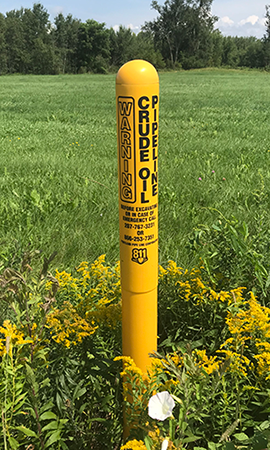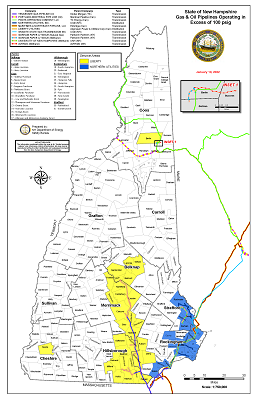Pipeline Safety Overview
The New Hampshire Department of Energy Division of Enforcement oversees more than 3,431 miles of intrastate pipelines delivering gas to more than 133,500 customers within 54 communities in New Hampshire. Two natural gas utilities, one natural gas transmission operator, over 21 liquid propane gas operators, one propane-air distribution company, one master meter operator, and three methane operators are inspected at least once per biennium, although most are inspected annually. The Division utilizes 30 natural gas inspection modules with many including customized versions of federal inspection forms to conduct rigorous inspections of operators using a risk based methodology.
In 2021, New Hampshire expects to complete approximately 200 scheduled staff visits that include a sampling of nearly 2,032 miles of distribution mains feeding 1,379 miles of distribution services supplying approximately 133,500 metered customers. In addition, there are approximately 20 miles of intrastate transmission pipelines within New Hampshire. Areas served include 54 communities having a population base of approximately 836,000.
More than 900 jurisdictional propane systems are supplied by 21 liquid propane gas operators to 40 of the same communities that have natural gas service. In addition, there are 78 communities where LPG is supplied in which natural gas is not available. These propane systems represent an estimated 2,200 customers.
Three small liquefied natural gas (LNG) satellite plants are owned and operated by Liberty Utilities and are used for peak shaving during winter periods where liquefied gases are used as a supplement for the natural gas distribution systems.
One volume of liquid occupies approximately 1/600 the volume, of natural gas. LNG is composed of methane. Having a density about 45% that of water, it floats on water and is stored at cryogenic temperatures. LNG is odorless, colorless, non-corrosive and non-toxic. LNG cannot burn as a liquid but because of rapid vaporization the vapors will burn and rise into the surrounding air. The storage tanks consist of vacuum-jacketed double wall tanks with an inner wall of aluminum sandwiched with a layer of insulation. Although there is efficient insulation, heat enters the tank. This causes a small amount of LNG near the top of the tank to "boil off." Small amounts of LNG are continually boiling and being removed from the tank and after flowing through a heat exchanger are sent out to serve natural gas customers. Small gravel lined dikes provide containment in the event of a spill.
In 2019, compressed natural gas (CNG) debuted in Keene as a source of natural gas supply and feeds a small portion of the Keene gas system.
New Hampshire Gas and Oil Pipelines Operating in Excess of 100 psig
Franchise areas and gas pipelines operating at greater than 100 psig are shown on the map at right. These include interstate and intrastate pipeline operators, (distribution and transmission), regardless of state or federal jurisdiction.
The National Pipeline Mapping System has information for interstate gas and hazardous liquid pipelines regulated by the federal government. It is able to show detail down to the county level.
Full-Sized Map of State of New Hampshire Gas and Oil Pipelines Operating in Excess of 100 psig
Pipeline Siting
 Pipeline Siting within New Hampshire is dependent upon the type, functional use, and location of pipelines. Typical gas distribution pipelines such as mains and services are often located in public right of ways such as streets and sidewalks and on occasion, private drives. Local municipalities allow the pipelines, which are public utilities, to excavate via the use of street opening permits issued by the local community. Restoration restrictions, traffic control requirements, and construction constraints are usually contained within local ordinances of each community.
Pipeline Siting within New Hampshire is dependent upon the type, functional use, and location of pipelines. Typical gas distribution pipelines such as mains and services are often located in public right of ways such as streets and sidewalks and on occasion, private drives. Local municipalities allow the pipelines, which are public utilities, to excavate via the use of street opening permits issued by the local community. Restoration restrictions, traffic control requirements, and construction constraints are usually contained within local ordinances of each community.
Any pipeline, whether it is a service, distribution main, or interstate and intrastate transmission pipeline, needs a state issued license to cross over, under or through a state property such as state owned land, or state owned public water body. These include FERC and PHMSA regulated pipelines. Typically a petition is filed with the NH PUC requesting a license and a Commission docket is assigned. The Enforcement Division participates in the proceeding and a Commission order determines if a license should be granted and what conditions are applicable. Recent examples of these crossing reviews are found in the Table below. Many of the crossings are now performed using directional drilling techniques which minimizes impact on the environment, reduces environmental permitting, and allows for less disruption to the land or water body being crossed. The Enforcement Division often conditions crossing recommendations involving directional drills to incorporate best practices found in North American Society for Trenchless Technology's (NASTT's) Horizontal Directional Drilling Good Practices Guidelines. Hyperlinks to Commission Orders and Staff Recommendations are included within the Table. Commission issued licenses by year can be found in the New Hampshire Public Utilities Commission's Virtual File Room.
An exception to this is highway crossings such as bridge crossings and pipelines located in Rights of Way owned and maintained by the New Hampshire Department of Transportation (DOT). The New Hampshire DOT requires a standard Use and Occupancy Agreement be completed as outlined in the New Hampshire Utility Accommodation Manual.
PUC Docket #11-138 Gorham Paper & Tissue Crossing with Natural Gas of Androscoggin River, Berlin
- 6/13/2011
- Recommendation 7/8/2011
- PUC Order 25,255
PUC Docket #11-157 Gorham Paper & Tissue Crossing with Landfill Gas of Androscoggin River, Berlin
- 7/9/2011
- Recommendation 8/8/2011
- PUC Order 25,267
PUC Docket #13-226 Liberty Gas Distribution Crossing of Soucook River, Pembroke
- 7/29/2013
- Recommendation 9/5/2013
- PUC Order 25,572
PUC Docket #16-223 Liberty Gas Distribution Crossing of Soucook River, Loudon
- 2/10/2016
- Recommendation 6/15/2016
- PUC Order 25,925
PUC Docket #16-471 Granite State Gas Transmission Crossing of Pomeroy Cove
- 4/28/2016
- Recommendation 6/21/2016
- PUC Order 25,927
PUC Docket #16-489 Unitil Gas Distribution Crossing of Cocheco River, Dover
- 4/25/2016
- Recommendation 1/25/2017
- PUC Order 26,021
PUC Docket #16-667 Unitil Gas Distribution Crossing of Exeter and Squamscott River
- 6/27/2016
- Recommendation 11/23/2016
- Secretarial Letter*
PUC Docket #17-039 Unitil Gas Distribution Crossing of Little River, Exeter
- 3/8/2017
- Recommendation 8/10/2017
- PUC Order 26,053
PUC Docket #17-093 Liberty Gas Distribution Crossing of Beaver Brook, Pelham
PUC Docket #18-092 Liberty Gas Distribution Crossing of Ashuelot River, Keene
- 5/31/2018
- Recommendation 12/4/2018
- PUC Order 26,212
PUC Docket #19-074 Liberty Gas Distribution Crossing of Soucook River, Pembroke
- 4/4/2019
- Recommendation 7/1/2019
- PUC Order 26,284
PUC Docket #21-006 Liberty Gas Distribution Crossing of Lake Winnisquam, Tilton
- 1/20/2021
- Recommendation 3/24/2021
- PUC Order 26,471
*Commission determined no license was required
Large transmission pipelines and compressor stations often fall under the authority of the New Hampshire Site Evaluation Committee (SEC). By statute, the SEC is comprised of nine members (seven public officials and 2 members of the general public). Three of the designated seven public officials are Commissioners of the NH PUC. The SEC maintains a website of all certificates that it issues and has an extensive amount of docket related materials including routing of pipelines. Examples of previous dockets include Tennessee Gas Pipeline’s compressor station in Pelham, SEC Docket No. 2008-02. Tennessee Gas Pipeline’s Concord Lateral extension SEC Docket No. 2000-01, Granite State Gas Transmission relocation within Exeter, SEC Docket No. 2014-01. The Site Evaluation Committee has a set of rules which are applicable to gas transmission pipelines based on the criteria outlined in RSA Section 162-H:10-b.
Siting of interstate gas transmission pipelines also fall under the jurisdiction of the Federal Energy Regulatory Commission (FERC). For more information about interstate pipeline siting, visit the Federal Energy Regulatory Commission website.
Permitting for LNG facilities used for interstate transportation may fall under the Department of Energy, FERC and PHMSA for siting and design. Potential LNG siting for off shore applications is very limited in New Hampshire resulting from the small footprint of New Hampshire’s coastline.
The Pipeline Safety Trust has an excellent guide available for landowners to consider when pipelines are potentially sited in the vicinity of businesses and residents.




